Species that have been introduced into areas outside their natural range through human actions and that pose a threat to native wildlife, are known as invasive non-native species. Sadly some have made their way to Normandy, affecting our native wildlife. However, you can help, by recognising them and reporting them, and even taking measures to control them. Read these details, from FNW Committee member, Bill Stanworth, on three such species to look out for.
The box-tree moth (Cydalima perspectalis) has been recorded for the first time in Normandy at Springhill garden. Adult moths were attracted to a mercury vapour lamp in July 2020 and later in the year larvae were found on its foodplant, box (Buxus sempervirens) growing in the same garden. The moth is a native of the Far East and so its arrival in Europe (in 2006) is thought to have been from imported box plants – ugh.
The first record of the moth in the U.K. was from Kent in 2007 but a year later it was found in Weybridge, Surrey. Since then the moth has been gradually increasing and from distribution maps the moth may have been in our area for a year or so. Papers about the moth and its distribution can be found on the RHS website.
The adult moth, shown below is large and very distinctive. Its markings are variable and even a brown form exists. The stripy green caterpillar is also quite distinctive and is shown resting below on its foodplant. It creates silk strands that tie leaves together forming a lair from which it can feed and retreat into, in times of danger.
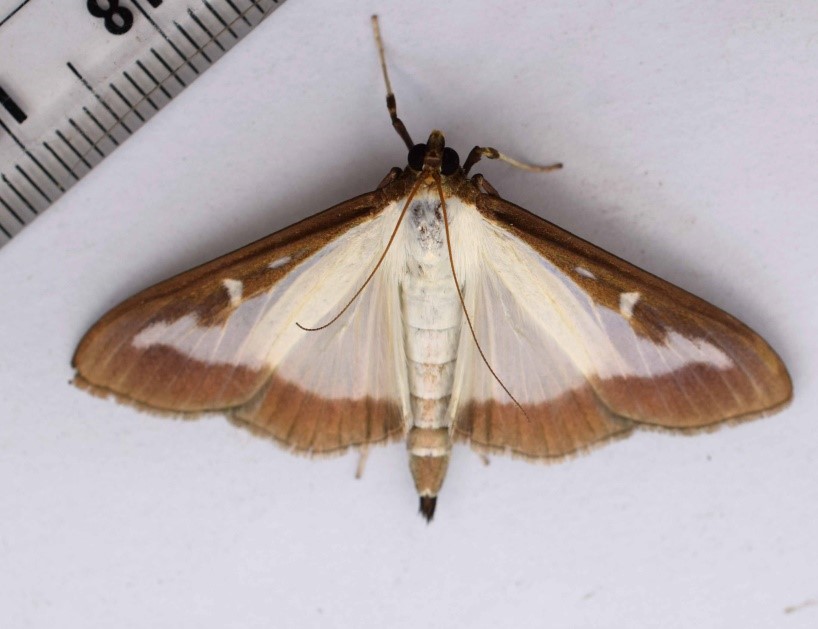
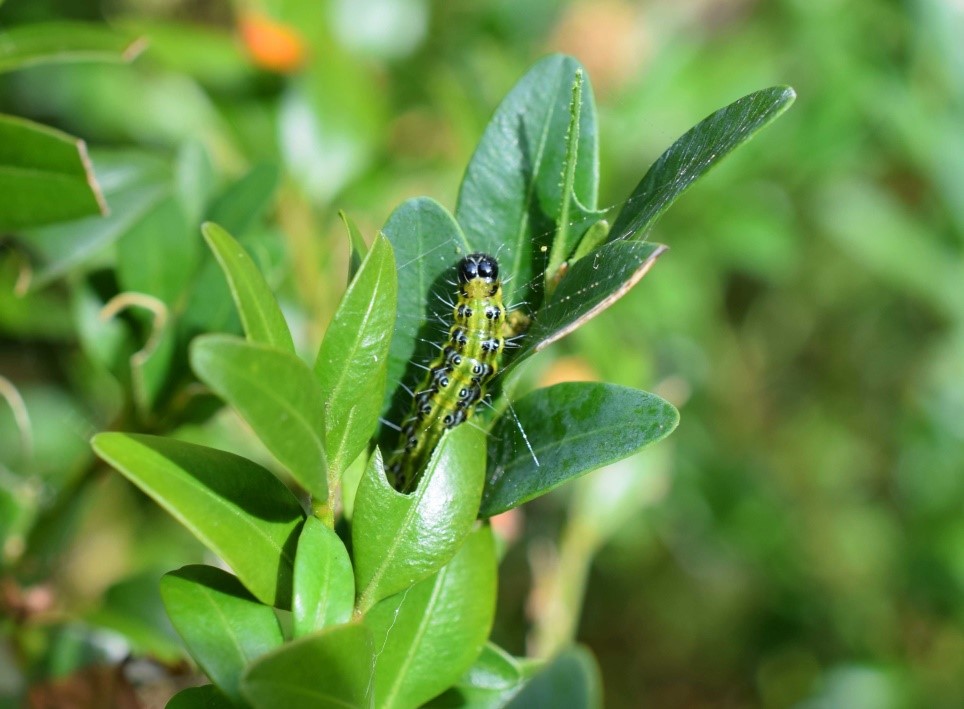
You can see from the photos below that even in less than one season they can seriously damage the plant. Feeding signs and frass are shown on the left and serious defoliation on the right. If you see this happening to your box bushes please check with the RHS and other websites for control methods (preferably using the non-pesticide methods).
We urge you to control this species as box is a native plant in southern England and it could have a serious effect on our best-known native boxwood at Box Hill, Surrey and other sites in the county and country. If you see the box-tree moth the RHS would like to know, you can submit your records on their website via their box-tree moth survey.
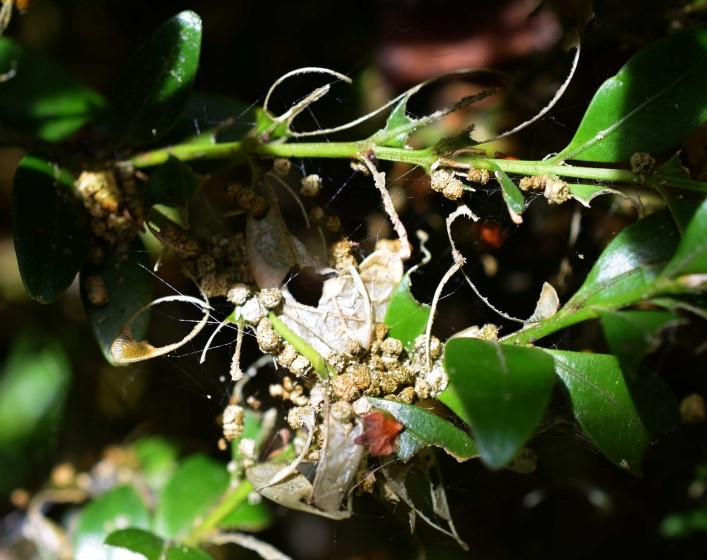

The second pest to look out for is the Agapanthus gall midge, which was also found in Springhill garden for the first time in 2020. It’s another devastating pest (if you grow Agapanthus in your garden!), a fly this time, that lays its eggs on the young Agapanthus flower buds. The tiny, creamy-yellow larvae develop and cause the flower bud to become distorted, go brownish and most fail to open. A photograph of the affected buds (here detached from the plants) is shown below.
According to the RHS the midge causing this was new to science and only discovered in 2014, this time at Wisley but it is probably a native of southern Africa, home of the plants. Control methods are given on the RHS website. Agapanthus flowers are popular with some native pollinators; an example shown here is probably a melanistic garden bumblebee (Bombus hortorum) from Springhill garden. This one spent a lot of time on this white flowered variety! Sadly many Agapanthus flowers at Springhill were ruined this year.
The RHS are asking for help from gardeners who have seen agapanthus gall midge or damaged flowers and request you send photos of symptoms on the flowers and buds, plus opened buds showing larvae where possible, to entomology@rhs.org.uk on their website.
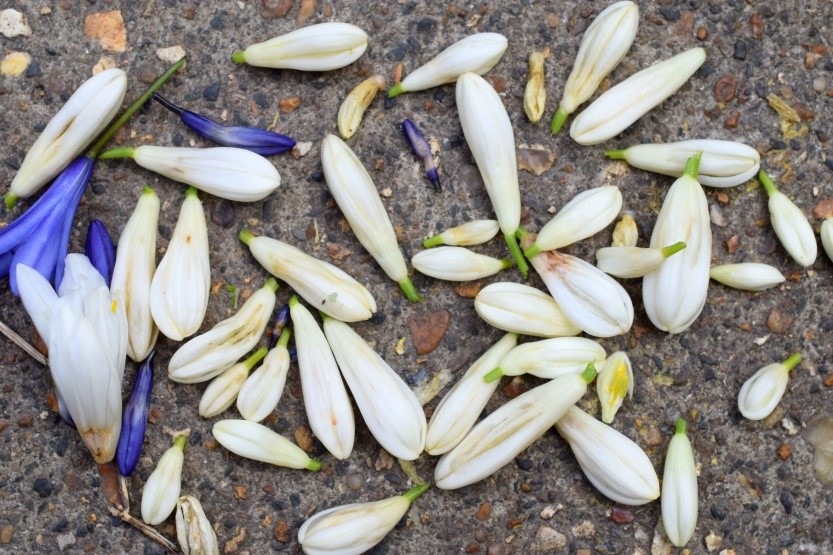
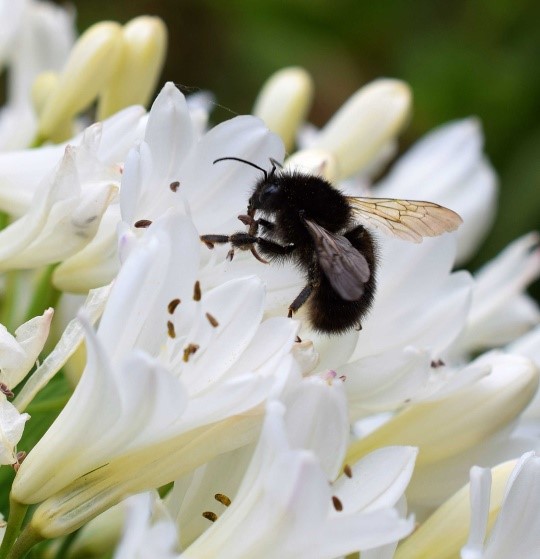
Another invader and potential pest is the gypsy moth (Lymantria dispar). The male shown below was attracted to a mercury vapour lamp at Springhill garden on 7 August 2020. On mainland Europe the moth can be a serious pest, stripping broadleaved trees (particularly apple, plum and willows; oaks and poplars in forests) and bushes.
Look out for patches of eggs covered with yellow/brown hairs on trunks and walls over winter or for large dark grey/black hairy caterpillers with reddish spots from April to June/July. Apparently the hairs don’t cause irritation of the skin unlike the oak processionary moth. The RHS website says ‘whilst a single defoliation from this caterpillar even early in the season, should not affect the vigour of a host plant, repeated defoliations can have an adverse effect’ and advice is given with regards control. They also very sensibly say ‘where possible tolerate populations of caterpillars’.
This moth (not mentioned/recorded in ‘The Larger Moths of Surrey’ [Graham A. Collins] published by SWT in 1997) was a former resident in the East Anglian fens but it lived on bog-myrtle and creeping willow and so wasn’t considered a pest. The European strain was accidentally introduced and has spread rapidly in the London area. Hopefully, as the large bodied females are mostly flightless, we won’t be troubled for a while.
There is no statutory requirement to notify sightings of gypsy moth to the plant health authorities but you can report serious damage to the government’s ‘Forest Research’ website: TreeAlert (their on-line pest reporting tool).
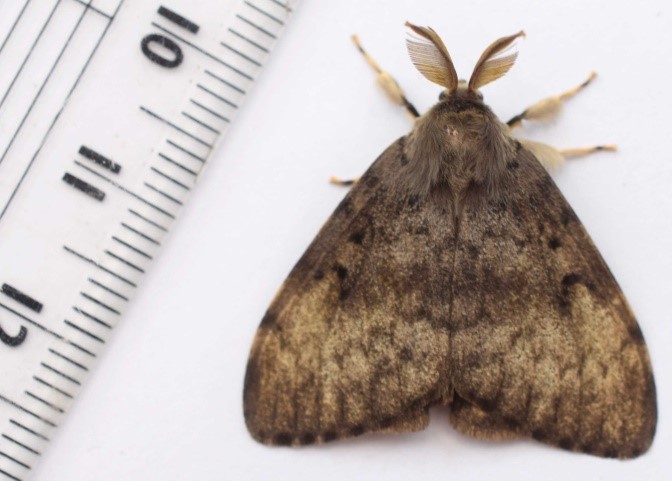
2018 saw the first arrival of the oak processionary moth (Thaumetopoea processionea) to Normandy (see our previous article). No moths were seen in Normandy in 2019 as far as we know but you may have seen that the Forestry Commission have erected posters warning the public to be alert for them and report them when seen. In addition at least one team has been seen on Normandy Common searching for evidence of their presence. This year three males were attracted to the mercury vapour lamp at Springhill so please stay vigilant.
